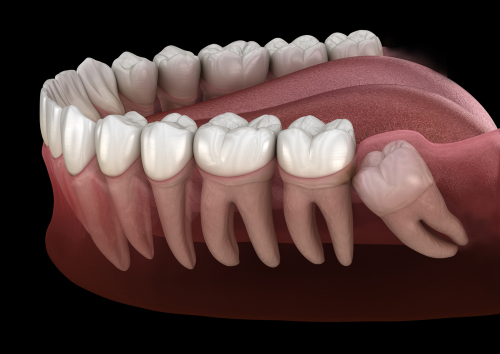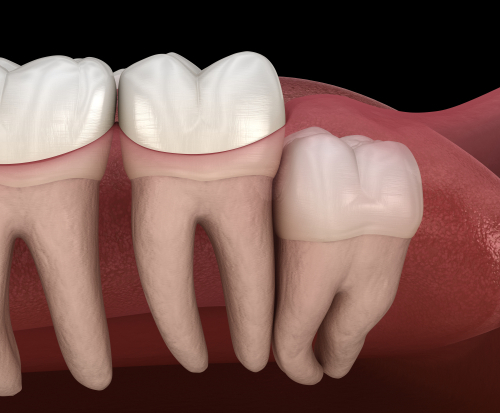
Extracting the Wisdom Teeth (the “eights”)
Wisdom teeth, or actually the third molars (the “eights”) increasingly pose a problem that can be resolved by removing them. Due to the human evolution over the course of thousands of years, there is a tendency for smaller and shorter dental arches. Our ancestors had "nines" and even "tens", which, with the change of diet gradually faded out of existence. Currently, we are witnessing an identical mechanism that meets the eighth teeth - many people do not have these teeth anymore, and often those who have them suffer from ailments associated with the lack of space for them in their mouths.

Wisdom teeth erupt later than other permanent teeth. Most often this occurs above the age of 18, even at age 30. Due to the development of the facial part of the skull, where the bones supporting the dental arches only develop to a certain extent, the third molars are often incorrectly positioned, erupt outside of the dental arch or become impacted in the bone – the tooth is completely impacted in the bone of the mandible or maxilla or it is partially impacted or covered by bone. In each of the cases described, there may be pathological conditions that force the patient to visit a doctor, or the dentist recognizes these conditions during a routine dental examination. Due to the location of third molars and their frequent impaction, radiological diagnostics are necessary to accurately determine the location of these teeth and their effect on neighboring anatomical structures. This is important both at the stage of qualifying the tooth for extraction and planning the surgery itself.
Considering the mechanisms in which the third molars negatively affect the general health, the indications for their removal include the following:
 The Procedure.
The Procedure.
In the case of erupted teeth, the extraction of the wisdom teeth does not differ from the standard procedure. Under local anesthesia, a dental surgeon uses special instruments - elevators and forceps to remove the tooth from the dental alveolus. The resulting wound is secured, and the patient leaves the office with instructions to avoid excessive postoperative complaints and allow the proper healing of the alveolus.
When the wisdom tooth is impacted, the course of the procedure also includes a series of steps that allow for the extraction of the tooth from the bone. Under local anesthesia, the mucous membrane, which covers the impacted tooth, is incised, and then with the help of appropriate drills the dental surgeon uncovers the tooth. Often due to its location, it is cut into pieces so that it can be easily and less traumatically removed. After cleansing the wound, the surgeon places sutures that allow proper healing. As with a normal extraction, the patient receives instructions for the proper healing of the post-extraction socket.
The extraction of wisdom teeth usually takes place without serious complications, however, due to its nature, the patient has to assume that a few days of convalescence may be necessary. Only cold and liquid foods should be consumed on the day of the surgery. In order to reduce swelling, it is recommended to use cold compresses immediately after the anesthesia wears off. In the event of pain, the patient may take medications prescribed by the doctor. It is particularly important to avoid smoking, also in the form of e-cigarettes, because these agents significantly impair healing of the post-extraction socket, which can lead to unpleasant complications. In spite of some inconveniences described, the vast majority of patients quickly return to full strength and are able to function normally on the same day. The doctor performing the procedure gives each patient detailed instructions, taking into account the specific conditions and complexity of the procedure performed. Therefore, the patient leaves the surgery with detailed instructions and care of the post-extraction socket.